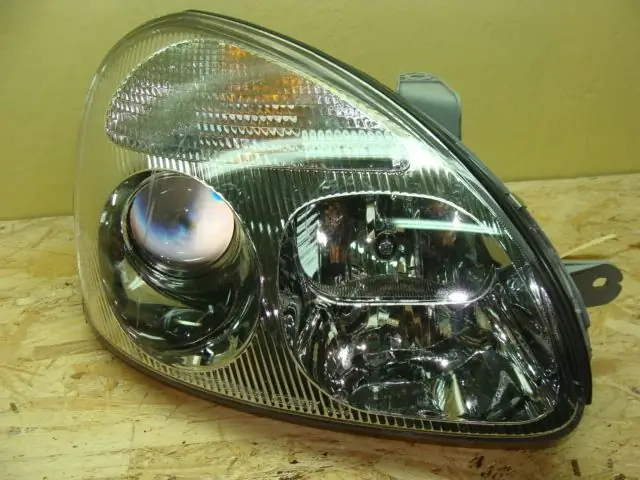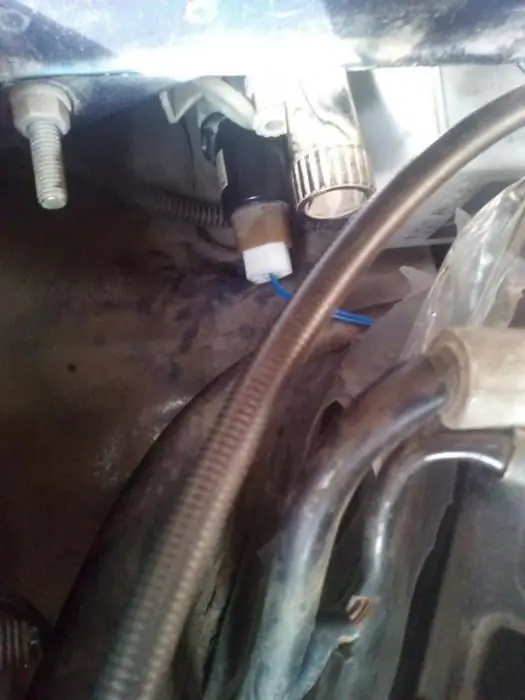2025 Author: Erin Ralphs | [email protected]. Last modified: 2025-01-22 21:14:14
Electrical headlight corrector is a tool for changing the direction of the beam of light from the headlights. By default, VAZ cars have a hydraulic drive with a corrector, which is less attractive and quickly fails. Therefore, many car owners prefer to install electric drives rather than hydraulics. They are much more reliable, easier to operate, consume very little current, and therefore will not affect the operation of the entire car as a whole. Adjustment knob can be mounted in any convenient location.
What proofreaders are for

The main characteristic of the passing beam for any car is the cut-off line. This is the line that separates light and darkness, it is on it that the illuminated area in front of the car ends. The driver sees nothing further. Moreover, this border is located at a different distance from the car - it all depends on acceleration and workload. The more mass the car transports, the higher the beam of light is located.
The VAZ-2110 headlight corrector is able to correct this situation. If, when moving without load, the beamis in the normal position, then with an increase in mass, it will shift upward. You can open the hood and lower the reflectors a little - there are even special handles for this. But after all, in one trip, the mass of the car can change several times - here you don’t run into settings. It would be much more convenient to carry out adjustments from the cabin. This is exactly what the correction system allows you to do.
Varieties of electric correctors

By the type of work, the following types of electric correctors can be distinguished:
- Manual - adjustment is made using the switch on the instrument panel.
- Automatic - correction is performed using a body position sensor.
Among the manual ones, hydraulic, pneumatic and mechanical ones can also be distinguished. But they are less relevant. The VAZ-2115 headlight corrector is much more efficient in operation and allows you to automate the headlight setting.
Electromechanical types of correctors

This type of device is high-tech, it is the most in demand and widespread. Its design is simple, consists of several elements:
- Reduced motors for each headlight.
- 4 position switch.
- Wiring.
- Fuse.
If you use such a device, you will need to do the following:
- Dismantle (if installed) the corrector hydraulic drive.
- If the switchIf you plan to install in another place, then the first step is optional. The best place to mount the derailleur is to the left of the steering wheel.
- Lay the wiring to each headlight. It is advisable to connect the wires to the bundles with special plastic ties.
- Install new stepper motors in place of the adjusting rods of the old hydraulic corrector.
- Connect the wires to the stepper motors.
- Since this device consumes, albeit a small current, it is necessary to install a 7.5 Amp fuse in the power plus gap. This device will save you from a short circuit. But it is best to calculate what is the maximum current consumed by the entire system. Based on this value, select a suitable fuse with a margin of 25%.
It is best to connect the VAZ-2109 headlight corrector to the wiring that comes from the ignition switch. This will completely de-energize the circuit when the ignition is off, and this will increase the reliability of the device and safety.
Auto corrector operation

This is a more advanced solution, since during operation the possibility of interfering with the system is completely excluded. They are widely used in the optics of new cars and in xenon headlights. In the latter, the beam of light has a high intensity, so it is imperative to set a correction - drivers moving in the opposite direction will not be blinded.
The application of automatic corrector is very wide, from car body to black and whiteborder distance is the same regardless of:
- Irregularities in the road surface.
- Vehicle speeds.
- Accelerating.
- Loads.
The main components of the automatic corrector
The normal operation of the system is ensured by:
- Car body position sensors - usually 2 or 3 (rear and front).
- Control unit on a microcontroller with the simplest operation algorithm.
- Actuators - stepper motors in the headlights.
- Wiring.
With the help of sensors, the distance to the road surface in front and behind the car is controlled. With the help of an electronic control unit, the angle of inclination of the machine is calculated. And, depending on the speed of the car, the light beam is adjusted. Almost all automatic systems provide for manual adjustment - a switch is installed for this purpose.
Installation of automatic corrector

To carry out work on the installation of an electric headlight corrector on a VAZ-2110, you will need:
- Dismantle the headlights and completely get rid of the old corrector drive (if installed).
- If necessary, increase the hole in which the new drive is planned to be mounted.
- Install new actuators on the headlight, use sealant if necessary. In some cases, it is necessary to completely change the design, make large holes, and install electric motors in them. To prevent dust from getting inside the headlight, be sure to seal all the crackssealant.
- There is one requirement for installing a ride height sensor - the distance to the road surface is about 260 mm. Mounting is carried out on the rear and front axles.
- Wires from the sensors to the control unit can be laid through the tunnels in which the brake pipes are located. If there are no such tunnels, then simply connect the wires with the tubes with clamps.
Now you can connect the entire system to the on-board network and try it in action.
Revision cost
The price of an electric headlight corrector is considerable - the simplest ones can be purchased for 1500-3000 rubles. It is quite possible that it will be easier to install a standard hydraulic corrector on a VAZ, which costs several times less - 300-500 rubles, but its service life is also not very long. Yes, and with the installation of the device can be problems. As for automatic systems, they have an even greater cost - over 13,000 rubles. For the Russian car industry, this is too high a price.
Recommended:
Tuning headlights on "Prior": description, interesting ideas, photos

Despite the fact that the Lada Priora has a quite modern appearance by today's standards, not all owners of this car are satisfied with its factory design. And in order to improve the appearance and give originality, many carry out external tuning (aka facelift). Only some elements of the body of the car, including optical instruments, are subject to changes. Tuning headlights on Priore is a fairly popular operation to change the appearance of a domestic car
Installing xenon in lensed headlights: installation features, regulatory documentation

Good road lighting at night makes the trip more comfortable and safer. To improve illumination, drivers put lensed optics. Is it possible to combine xenon and lensed headlights, the advantages and disadvantages of the combination - read the article
Xenon headlights: benefits and installation

Xenon headlights, unlike others, have two built-in electrodes instead of an incandescent coil. They are located at a short distance from each other in a quartz glass tube filled with metal s alts and gases. Between these electrodes, with the help of a high-voltage pulse, the gas acquires an electrically conductive property and an electric charge occurs. Therefore, xenon headlights are also called gas discharge
Lenses in headlights. Installation. Replacing lenses in car headlights

Not every car is equipped with good optics, which allows the driver to feel confident on the night road. Owners of inexpensive brands independently modify the headlights, making them more modern and bright. Lenses are excellent for these purposes, especially since the installation of a lens in headlights is available to everyone
Why do headlights sweat? What to do so that car headlights do not sweat?

Fogting headlights is a fairly common problem that drivers and owners of a wide variety of vehicles often face. At first glance, this defect does not seem so critical, and its elimination is often shelved. But all the insidiousness of this problem lies precisely in the fact that it manifests itself most clearly at the most inopportune moment

